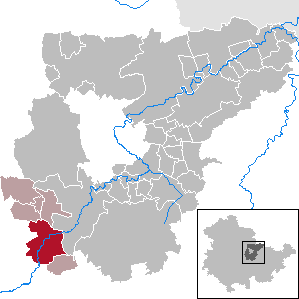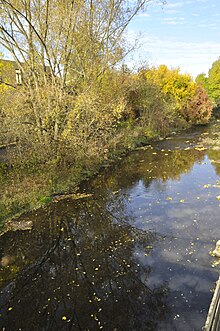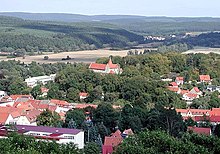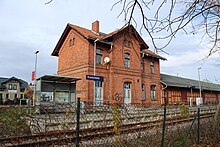Crane field
| coat of arms | Germany map | |
|---|---|---|

|
Coordinates: 50 ° 51 ' N , 11 ° 12' E |
|
| Basic data | ||
| State : | Thuringia | |
| County : | Weimar Country | |
| Management Community : | Crane field | |
| Height : | 301 m above sea level NHN | |
| Area : | 23.1 km 2 | |
| Residents: | 3363 (Dec. 31, 2019) | |
| Population density : | 146 inhabitants per km 2 | |
| Postcodes : | 99446-99448 | |
| Area code : | 036450 | |
| License plate : | AP, APD | |
| Community key : | 16 0 71 046 | |
| LOCODE : | DE KHF | |
| City structure: | 3 districts | |
City administration address : |
Alexanderstraße 7 99448 Kranichfeld |
|
| Website : | ||
| Mayor : | Enno Dörnfeld ( CDU ) | |
| Location of the city of Kranichfeld in the Weimarer Land district | ||
Kranichfeld is a country town in the Middle Ilm Valley in the south of the Weimarer Land district and the seat of the administrative association of the same name .
geography
Kranichfeld lies in the wooded hill country of the Ilm-Saale-Platte in a valley basin of the Ilm . The mean altitude is about 300 meters above sea level. NN.
The place consists of the core town Kranichfeld and the separate districts Stedten (Ilm) and Barchfeld . On January 1, 1976, the former municipality of Stedten / Ilmtal was incorporated into the municipality of Barchfeld ad Ilm , which in turn was incorporated into the city of Kranichfeld on April 9, 1994.
history
After Wolfgang Kahl , Kranichfeld was first mentioned in documents 842–856.
Kranichfeld was originally divided into two parts: the Planhof and the Judendorf . In 1233 the bishop of Mainz had suzerainty. It was in the possession of the Schwarzburger as pledge, in 1398 the pledge came to the Wettins . The lords of Kranichfeld , who built the upper castle, mentioned for the first time in the 12th century, and the lower castle a little later, were the tenants. In 1172 the rule Kranichfeld was divided into the upper and lower rule. The male line of the Kranichfelder family died out around 1380 , and their inheritance fell to the Burgraves of Kirchberg . In the middle of the 15th century, the castle and estate of Ober-Kranichfeld were sold in 1453 to the Reuss family , into which a daughter from the Kirchberg family had married. The subordinate rule (Nieder-Kranichfeld), however, came to the Counts of Gleichen-Blankenhain in 1455 . These died out in 1631, whereupon the fiefdom of the Archbishopric of Mainz fell back. This sold in 1639 the fief Gleichen Castle , Castle Blankenhain and the Niederburg Kranichfeld to Melchior von Hatzfeld , a commander in the Thirty Years' War. He died unmarried in 1658 and was inherited by his brother Hermann von Hatzfeldt . The Hatzfelder, however, lived in other regions, at Holdbergstetten Castle in Middle Franconia or in Trachenberg in Lower Silesia . The last descendant of this line, Friedrich Karl Franz Cajetan, Prince of Hatzfeld-Gleichen-Trachenberg (1773–1794), died without descendants; then the fief of the Gleichener Grafschaft, including Nieder-Kranichfeld, fell back to the Archdiocese of Mainz.
From 1615 to 1920 Ober-Kranichfeld belonged to various Thuringian principalities, most recently from 1826 to the Duchy of Saxony-Meiningen . In 1650 the place received city rights. The sub-rule belonged to the Counts of Schwarzburg , from 1803 Prussia , from 1815 Saxony-Weimar-Eisenach . Despite the division of the rulers, Kranichfeld always formed a community. In 1830 it had 1,300 inhabitants, and in 1888 it was connected to the railway. The districts were united under the rule of Saxony-Meiningen from 1912 onwards.
Kranichfeld has an interesting castle history. Five fortified structures (castles and palaces) are proven:
- Burgstelle Turmhügelburg New meal , a moth (high moth) , for which no written documents are available. The castle hill has been preserved. The hill is overgrown by a circular forest and clearly visible from the keep of the upper castle on the other side of the valley in a field. The name “Neues Mahl” is intended to indicate that the tower hill was later used as a court for home citizenship and complaint courts. The hill is about 7 m high and about 30 m in diameter. A former ditch can hardly be seen. The small manor castle is said to have consisted of a residential tower with an outbuilding.
- No historical documents are known of the Schleussenburg castle site . It was an older refuge. The place Schleusdorf is said to have been in it.
- The "Oberschloss" was preceded by a castle, which secured the river crossing of the Ilm. Lords of Kranichfeld were first mentioned in 1143 and 1152 . After 1172 the upper castle was built. After the counts died out, the castle came to the burgraves of Kirchberg in 1389, who assumed the Wettin sovereignty in 1398. In 1550 it was converted into a castle.
- The Lower Castle , today's low castle was first mentioned in 1147 in documents. The oldest mention comes from 1143 (?), As the seat of a sideline of the Counts of Käfernburg-Schwarzburg , who shared their property in 1172. In 1906 Fräulein Rauchfuß became the new owner of the Niederburg, which gave the house a new look as it is today. In 1976 the Niederburg was a popular FDGB vacation property. In 1989, at the time of political change , the castle became the property of the city of Kranichfeld, and in 1994 a long-term lease agreement for the use of the castle was concluded with the company Muehl Product & Service Kranichfeld . During this time, renovation work was carried out. The roof was re-covered, the kitchen was removed and a new sanitary facility was built. The castle courtyard was redesigned and a modern heating system was installed. After the insolvency of the Muehl company, the Niederburg was again owned by the city of Kranichfeld. At the moment there are no exhibitions or the like in the castle, there is also no gastronomy, but it can be rented for family celebrations from the tourist office.
politics
City council
The local elections on May 26, 2019 led to the following result, with a turnout of 54.7%:
| Party / list | Share of votes | Seats |
| CDU | 29.0% | 4th |
| FDP / Free Citizens | 17.2% | 3 |
| Active for Kranichfeld (AfK) | 53.8% | 9 |
coat of arms
The coat of arms, which comes from that of the Counts of Kranichfeld , shows a yellow ( heraldic: golden) crane standing on a white ( heraldic: silver) background on a green field (foliage) , holding a stone in the raised right claw, above the crane a blue one A cloud from which a hand with a red sleeve extends a green palm branch, with the year 1650 underneath it in black .
For a long time in the history of the town, coats of arms were used that only showed the crane with stone. Until the 1980s, the coat of arms was on a white background a seeing behind ( heraldic: resist seeing) yellow crane with black tail, a stone in his raised right claw holding. The coat of arms showed no green field under the crane, no cloud with an arm and palm branch and no year 1650. An older version up to the 1920s had a green field and a pure gold crane.
- Heraldic description:
- In silver on a green field in the base of the shield there is a golden crane (not opposed , as on older coats of arms), holding a stone in the raised right claw, in the head of the shield on the right a blue cloud, from which a hand with a red sleeve reaches a green palm branch, underneath on the right the year 1650 in black. In heraldry , coats of arms are always seen from the wearer (from behind). The year means the granting of city rights .
Town twinning
- Diemelstadt in Hessen, since 1990
- Höchstadt ad Aisch in Bavaria, since April 27, 1991
In an official gazette of the administrative community Kranichfeld the dissolution of the town twinning association was wrongly understood as the termination of the town twinning. This is not the case. The partnerships with Höchstadt ad Aisch and Diemelstadt continue to exist.
Culture and sights
- The upper castle is an early Renaissance building from 1530 with older predecessors from the 12th century. The gatehouse was built in 1906 based on a design by the architect Bodo Ebhardt . In 1934 the castle burned out. The last owner gave the castle to the "Reichsführer SS " Heinrich Himmler in 1941 , who wanted to convert the ruins into an SS cult site and driving school. Hundreds of prisoners from the Buchenwald concentration camp were assigned to do forced labor under catastrophic conditions and the terror of the SS in which more than 100 prisoners lost their lives, as a memorial plaque in the courtyard reports. After the war, the castle was left to decay. 1970 was threatened with demolition. In 1981 a support group was formed to save the castle. From 1986 to 2001 the ruin was secured and partially renovated. The castle was taken over by the Thuringian Palaces and Gardens Foundation in 1994 . Today the complex houses a museum about the castle history.
- The Niederburg , first mentioned in 1233, owes its present shape to a renovation in 1906. There is an open-air theater in the immediate vicinity.
- The Michaelis Church is a late Gothic building built between 1496 and 1499 . During the years 1889/90 renovation work was carried out on the church, and the church tower was renovated and raised by nine m, the half-timbered fixtures were removed and the interior furnishings were changed. The church received a new pulpit from Christian Friedrich Kantner and a new organ from the court organ builders, the Poppe brothers . The church is a Protestant parish church for Kranichfeld and Stedten .
- As a protected ground monument, the Enzenburg is the remainder of a small late medieval manor castle. It belonged to a village called "Enzenrode" mentioned in 1143. The ramparts and moats of the former castle can be found on the road towards Hohenfelden just before the reservoir on the right-hand side. A display board explains details.
Memorials
- In the local cemetery, a memorial with a memorial commemorates 26 perished forced laborers of various nationalities, ten of whom are named.
- Since 1984 a memorial stone on Ilmenauer Straße (near the confluence with Lindental) has been commemorating the victims of a death march by prisoners from Buchenwald concentration camp who were driven through the town in spring 1945.
Museums
- Baumbachhaus: permanent exhibition on the life of Rudolf Baumbach and changing exhibitions on regional topics
- Upper Castle: Exhibition on the history of the Upper Castle and the city
Regular events
- Rose Festival every summer (usually June) with parade and events on the open-air stage near the Niederburg and other venues (Oberschloss, Anger), every two years in conjunction with the Thuringian Dance Festival
- Medieval festival every year at Whitsun in the upper castle
- Concerts and opera performances in summer on the open-air stage near the Niederburg
Leisure and sports facilities
- Tao Te Weimarer Land eV (sports club for karate, zumba, fitness, health sports)
- Stadium (soccer, field handball, athletics) with bowling alley
- A sports hall that can also be used for cultural events ( Dreifelderhalle )
- Adler- und Falkenhof Schütz on the Niederburg
- Kranichfeld is located on the 124-kilometer Ilmtal cycle path .
Economy and Infrastructure
The largest company in Kranichfeld is Neumann Bauelemente GmbH with 90 employees (2007) and Mühl24 GmbH, wholesalers for building materials, sanitary ware and tiles.
traffic
Kranichfeld is on the B 87 Ilmenau - Bad Berka - Weimar . More roads are the national road LIO52 according Erfurt , to A 4 and the reservoir Hohenfelden and the circuit road Teichelmann , a district of Rudolstadt .
With the Kranichfeld train station there is an hourly train connection to the 25 kilometer long Ilm Valley Railway to Weimar via Bad Berka . The Ilm Valley Railway ends in Kranichfeld. Plans to extend it to Stadtilm on the Arnstadt – Saalfeld railway line were discarded at the beginning of the 20th century.
Educational institutions
- Elementary school Anna Sophia
- Regular school Anna Sophia
- Three kindergartens (two in Kranichfeld, one in Stedten )
- Kranichfeld City Library
Offices
- City administration and seat of the administrative community Kranichfeld
Personalities
Honorary citizen
For his commitment to maintaining the Baumbachhaus in Kranichfeld, Walter Scheel received honorary citizenship of the city in September 2006 .
sons and daughters of the town
- Georg Quitschreiber (1569–1638), composer
- Anton Hülse (1637–1712), Baroque architect
- Johann Friedemann Schneider (1669–1733), logician, physicist and lawyer
- Johann Albrecht Klein (1698–1778), astronomer
- Karl Friedrich Ernst Ludwig (1773–1846), journalist and publicist
- Wilhelm Thomas (1834–1897), President of the Landtag and member of the Reichstag
- Rudolf Baumbach (1840–1905), poet, e.g. B. Up on the yellow car
- Carl Bamberg (1847-1892), mechanic and entrepreneur ( Askania Werke )
- August Freysoldt (1856–1932), forester, "Rennsteig historian"
- August Baudert (1860–1942), SPD politician, member of the Landtag and Reichstag, persecuted by the Nazi regime
- Franz Nauber (1911–2001), horn player
- Wolfgang Kahl (* 1951), author on the history of medieval Thuringia
Personalities associated with the city
- Wolfgang Ratke (also Ratichius) (1571–1635), educator and school reformer, was persecuted for two years by the widow of Count Carl-Günther von Schwarzburg-Rudolstadt in the upper castle
- Anna Sophia von Schwarzburg-Rudolstadt (1584–1652), women activist
literature
- Renate and Otto Hahn: 350 years of the city of Kranichfeld, the surrounding villages and the world. Kranichfeld 2001, DNB 1003449778 .
- Beate Becker and others: Faces from Kranichfeld's past. Published by the Förderverein Baumbachhaus, Kranichfeld 2002.
- Georg Thielmann: The Ilm Valley Railway. Wachsenburgverlag, Arnstadt 2003, ISBN 3-935795-06-8 .
- Wolfgang Kahl: History of the city of Kranichfeld. A home book. Bad Langensalza 2012, ISBN 978-3-86777-438-3 .
Web links
- City of Kranichfeld
- Administrative community Kranichfeld
- Website of the association for the rescue of the upper castle
Individual evidence
- ^ Population of the municipalities from the Thuringian State Office for Statistics ( help on this ).
- ^ Federal Statistical Office: Municipalities 1994 and their changes since 01.01.1948 in the new federal states. Metzler-Poeschel, Stuttgart 1995, ISBN 3-8246-0321-7 .
- ^ Wolfgang Kahl : First mention of Thuringian cities and villages until 1399. A manual. 2nd, improved edition. Rockstuhl, Bad Langensalza 2001, ISBN 3-934748-58-9 , p. 36.
- ↑ schlossarchiv.de: Kranichfeld - castle ruins, palaces, manors and town
- ↑ Michael Köhler : Thuringian castles and fortified prehistoric and early historical living spaces. Jenzig Verlag Köhler, Jena 2001, ISBN 3-910141-43-9 , pp. 164-165.
- ↑ Thomas Bienert: Medieval castles in Thuringia. 430 castles, castle ruins and fortifications. Wartberg Verlag, Gudensberg-Gleichen 2000, ISBN 3-86134-631-1 , pp. 349-353.
- ↑ BekaThuringian State Office for Statistics, municipal council election 2019 in Thuringia - result Kranichfeld , accessed on July 25, 2019
- ↑ Franziska Nössig: Simple, fortified residence. In: Thüringische Landeszeitung . February 5, 2011.










